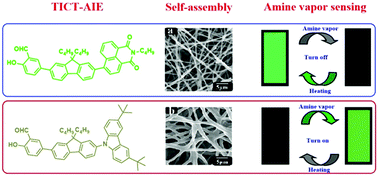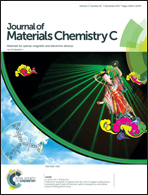AIE-active molecule-based self-assembled nano-fibrous films for sensitive detection of volatile organic amines†
Abstract
Self-assembled fibrous films are expected to be an efficient approach for volatile organic amine (VOA) detection because of their fast response and high sensitivity and facile preparation of portable instruments. Herein, two D–π–A type salicylaldehyde derivatives functionalized naphthalimides (SFN) and tert-butyl carbazole (SFC) were synthesized, and their photophysical properties were investigated systematically. Both compounds display significant aggregation-induced emission behaviors originating from twisted intramolecular charge transfer (TICT) and restricted intramolecular rotation (RIR). Moreover, hydrogen bonding and π–π interactions with the assistance of dipole–dipole interactions enable the formation of self-assembled fibrous films from SFN and SFC, respectively. In particular, nanofibril-based films are introduced to detect VOA vapors with high performance through deprotonation and the Schiff base reaction. The fluorescence intensity of the films is quenched dramatically for SFN and enhanced significantly for SFC after exposure to the VOA vapors. These salicylaldehyde derivatives can be used for the design of efficient fluorescent chemosensors, and their self-assembled fibrous films are promising sensors for VOA detection.



 Please wait while we load your content...
Please wait while we load your content...